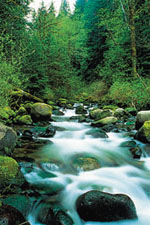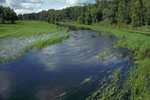|
STANDARDS AND GUIDELINES FOR PROTECTING WATER QUALITY
The USEPA has established a Federal drinking-water standard
or Maximum Contaminant Level (MCL) of 10 mg/L for nitrate.(28)
An MCL is a concentration above which adverse human health effects may
occur.
The USEPA(29) has established
criteria for un-ionized ammonia in surface water because of its
toxicity to fish. The chronic criteria vary from 0.07 to 2.1 mg/L of total
ammonia for pHs of 6.5-9.0 and water temperatures of 0-30 °C.
National criteria have not been established for concentrations
of dissolved phosphates in streams or ground water.
National criteria have not been established for total
phosphorus or total nitrogen in streams. The USEPA has established a desired
goal of 0.1 mg/L total phosphorus for the prevention of nuisance
plant growth in streams and other flowing waters not discharging directly
to lakes or impoundments.(29)
|

